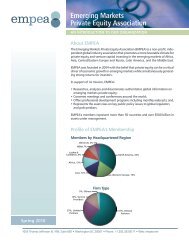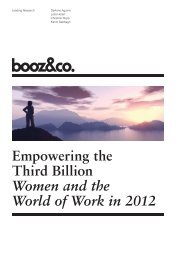Top 100 - Wamda.com
Top 100 - Wamda.com
Top 100 - Wamda.com
- No tags were found...
Create successful ePaper yourself
Turn your PDF publications into a flip-book with our unique Google optimized e-Paper software.
The DigitalRevolution:Shoppers and brands share the powerin the new <strong>com</strong>mercial democracyThe numbers tell the story.Apple is the world’s most valuable brand, followed byGoogle. Facebook, just seven years old, appears in theBrandZ <strong>Top</strong> <strong>100</strong> Most Valuable Global Brands for the firsttime, at No. 35.While the meteoric rise of these technology brands is<strong>com</strong>pelling, equally important is their impact, as brands inevery product sector respond to the fast-changing worldof digitized and disintermediated information.Last year, brands reached customers on brand andretailer Web sites, on Google and other search enginesand on mobile apps that rewarded shoppers forinteracting with brands. Some brands led the way.Others attempted to catch up.Few ignored the tide. As recent events in the Middle Eastdemonstrate, digitally connected people wield enormouspower to express their desires and influence each otherand events. The analogy to brands is imperfect, butrespecting it is imperative.As digital revolutionizes the relationship between brandsand consumers, interactions that could be adversarialincreasingly be<strong>com</strong>e collaborations aspiring to mutualbenefit and reciprocal trust.In these digitally enabled relationships, the role ofmarketer as brand builder, selling products to the public,is supplanted by the role of marketer as brand enabler,engaging the public’s help to improve products and raisecustomer satisfaction.In a digital creation story, the universe isn’t <strong>com</strong>pleted onthe sixth day. It’s a work in progress, a partnership aimedat perpetual renewal and relevance. One element remainsthe same, however – the desire for an apple.Collaboration and co-creationAt the start of last year, few people fretted that their livesfelt bereft of a digital gadget smaller than their laptopbut larger than their mobile phone. By the end of 2010,however, around 18 million of us owned iPads orother tablets.Apple understood that its customers wanted access todata and images anywhere, anytime, in easy-to-viewdefinition with an easy-to-use touch interface. In a spanof a few months, the brand met these needs with theiPad and iPhone 4.BrandZ <strong>Top</strong> <strong>100</strong> 2011: SECTORS/COMMENTARY 48Apple trusted that its customers would discover usesfor these products that would help organize, simplifyor <strong>com</strong>plicate, but mostly improve their lives. This cocreationapproach resulted in roughly 350,000 Appleapps, and it added value to the product and the brand.Another perhaps 250,000 Android apps were created.In a similar co-creation, brands improved productsand marketing based on <strong>com</strong>ments from customers inconversations on social networking sites. Co-creationalso was the basis of collective shopping sites such asGroupon, which help merchants and brands increasesales and shoppers increase savings. Digital enablesstrangers to connect around something they share in<strong>com</strong>mon – the desire for a bargain.Shift in how we view customersWhen brands enjoyed sovereign control over thedissemination of information about themselves, marketerscould choose a demographic – for example, 18-to-24-year-old women – and design an attention-grabbing,persuasive 30-second TV <strong>com</strong>mercial.That’s changed. Some of our interests cut across thetraditional demographic categories, often making ourdesignation as a Millennial or Boomer less relevant thanwhether it’s Monday morning or Saturday night andwhether we’re focused on planning for the week or forour next vacation.Brand success requires recognizing this changeand allowing customers to self identify, form groups,and access utilities and dynamic, well-built librariesof information. Last year, Pampers, No. 34 in brandvalue, launched an iPad app called “Wel<strong>com</strong>e Baby.” Itillustrated the development of a fetus in the womb andhelped expectant parents understand and track thestages of pregnancy.This kind of information is the currency of the digitaldemocracy. It changes brand-customer interaction from aseries of isolated transactions into an ongoing relationshipthat be<strong>com</strong>es deeper and more interconnected. Witheach encounter, the customer gains more knowledgeabout the brand and brand-related topics and the brandlearns more about the customer.Sustaining these relationships depends on transparencyand trust from both sides, brand and customer. Bothsides lose when the relationship deteriorates becausebrands collect information using stealth tactics orcustomers respond with a subterfuge of false information.
















